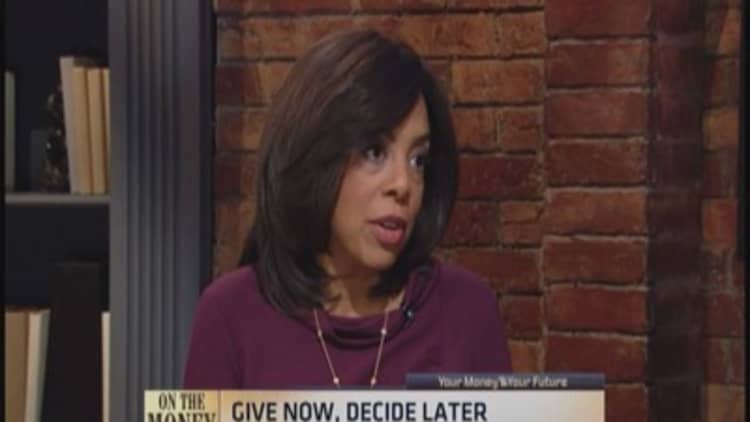The rise of donor-advised funds (DAFs) is a bane or boon for charitable causes, depending on whom you ask.
DAFs continue to be the fastest-growing vehicle for charitable giving in the United States. According to the 2014 Donor-Advised Fund Report by the National Philanthropic Trust, the number of DAFs in the U.S. has increased from 40,000 in 2000 to more than 217,000 last year. Contributions to the funds in 2013 were up 23.5 percent to $17.3 billion, and total assets in the funds increased 19.8 percent to $53.7 billion last year. The average DAF account size grew to over $247,000.
"It's an easy tool, structured in a way that people can have a sustainable giving program," said Eileen Heisman, CEO of the National Philanthropic Trust, which manages the fifth-largest DAF in the country. "A lot of people feel it's their own charitable foundation."
The reasons for the popularity of DAFs are straightforward: They're easy to set up, easy to use, they offer anonymity, and they offer a great tax deduction. Individuals can immediately deduct contributions to DAFs up to 50 percent of their adjusted gross income, and if they can't take the full deduction when they make the contribution, they can carry it forward for up to five years. People can also contribute appreciated stock to the funds, getting the full deduction of the market value of the shares and avoiding capital gains taxes.
Read MoreCharities struggle as donor-advised funds balloon
The funds are now offered by independent national organizations like Fidelity Charitable and Vanguard Charitable, increasing numbers of financial institutions and a large number of community foundations. The fund administrators vet the charities that people want to give to, typically provide a choice of investment strategies to manage the assets in the fund and handle all the paperwork involved in charitable giving.
The downsides of donor-advised funds
The positive take on DAFs is that they are expanding the philanthropy pie—not necessarily with immediate charitable contributions but with future giving down the road. The funds allow people to get the immediate tax benefit while they consider where they want the money to go.
"The funds are a great vehicle for people to accumulate money over time and build a hospital or a dormitory. We've had people do that," said Ben Pierce, president of Vanguard Charitable, which now manages almost $5 billion in assets, has over 10,000 individual accounts and was the eighth-largest grant-maker in the country last year. "Strategic philanthropy is the best philanthropy."
Critics of DAFs say they are slow to distribute money to charities. Fund administrators are required to pay out a minimum of 5 percent of aggregate assets they manage, but individuals have no minimum distribution requirement. They get the full tax deduction when they contribute to the funds, but aren't required to pay out a dime of the assets to charities.
Ray Madoff, a professor of law at Boston College Law School, suggests that charities and the people and causes they benefit would be a lot better off if people gave the money directly to the organizations rather than parking it in DAFs. She has suggested that the funds should be required to pay out their assets within a seven-year period.
Read MoreTo give is to receive: Your guide to tax-smart charitable donations
In his tax-reform proposal tabled early in the year, Rep. Dave Camp, R-Michigan, proposed an even shorter, five-year payout requirement for DAFs, in which accounts that don't distribute the money within that period will face penalties.

Another concern is the costs of DAFs. Financial institutions have piled into the market to gather assets and charge fees to manage them, and the costs vary widely across the industry. There are typically two fees: one for administration of the account and another for investment management of the funds.
The National Philanthropic Trust has an .85 percent (85 basis point) administrative fee. Depending on how active you want to be in the management of the account, the investment management fee can range from as little as the 10 basis points Vanguard Charitable pays annually to Vanguard to manage its roughly $4.6 billion in assets, up to 1 percent or more.
Proponents of the funds say DAFs are getting unfairly targeted. Sure, financial institutions have piled into the market to gather assets and charge fees to manage them, but private foundations pay advisers to manage assets as well. What's more, the payout ratios from DAFs as a whole are nearly 20 percent. That's about four times higher than the average payout of private foundations across the country and very close Camp's proposed five-year payout requirement.
Read MoreAre you giving too much to charity?
If people are worried about stagnant philanthropic structures, foundations may be the better target. They hold more than $600 billion in assets and on average pay out not much more than their 5 percent minimum annually.
"I think [DAFs] are a positive overall," said Keith Curtis, a consultant to nonprofit organizations and current chair of the board of the Giving USA Foundation. "They're introducing more people to philanthropy and helping them see what their gifts can do. That's a big benefit."
Curtis expects the growth of DAFs will moderate if the stock market cools off, but he believes their popularity will continue. "There's a lot of interest in these funds, and I hope they'll get people to think more philanthropically and do more for nonprofits," he said.
Source: NPT 2014 Donor-Advised Fund Report
- Fidelity Investments Charitable Gift Fund: $10.2B
- Schwab Fund for Charitable Giving: $4.8B
- Vanguard Charitable Endowment Program: $3.6B
- Silicon Valley Community Foundation: $3.4B
- National Philanthropic Trust: $1.6B
- National Christian Foundation: $1.4B
- Jewish Communal Fund of New York: $1.2B
- Greater Kansas City Community Foundation: $1.1B
- New York Community Trust: $1B
- Renaissance Charitable Foundation: $639M




